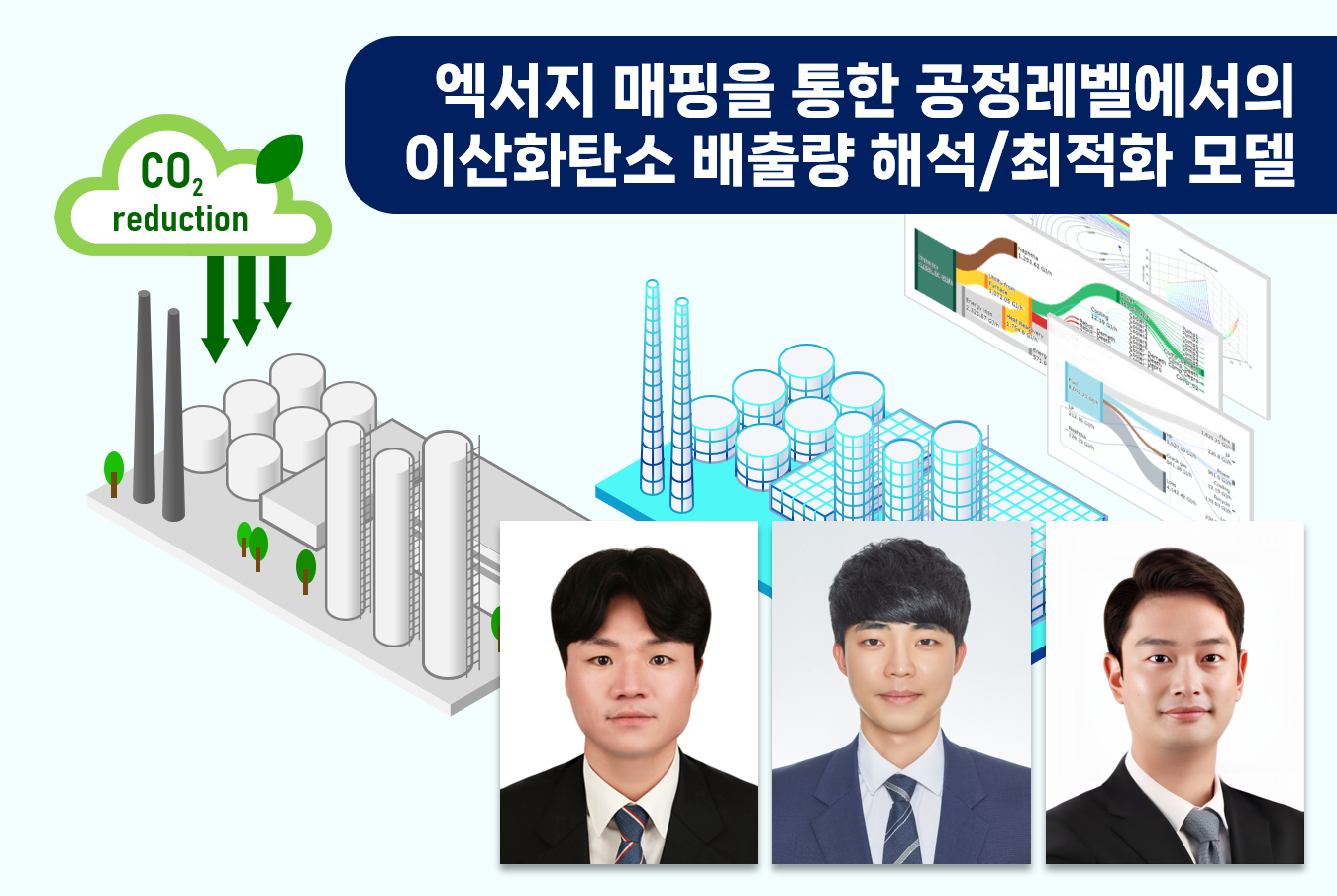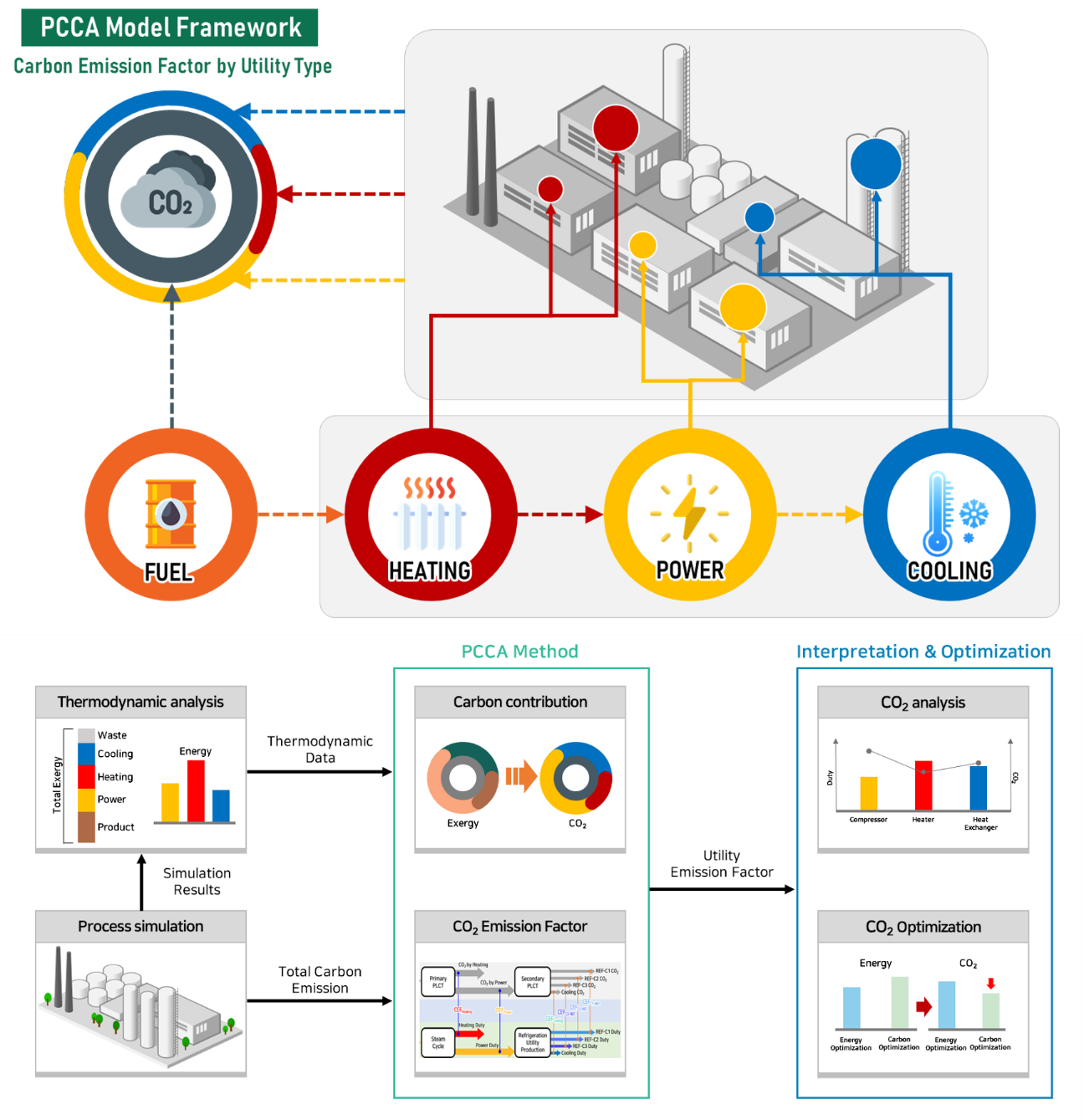- 작성일
- 2023.11.03
- 수정일
- 2023.11.17
- 작성자
- 이승란
- 조회수
- 362
[연구] 이인규 교수팀, 공정에서 배출되는 이산화탄소의 원인을 규명하여 발생량 저감 / 새로운 탄소 해석 및 저감 방법론 개발

응용화학공학부 이인규 교수팀은 공정 수준에서 배출되는 이산화탄소를 해석할 수 있는 공정 수준 탄소 기여도 분석(Process-level carbon contribution analysis, PCCA) 기술을 개발하고 이를 활용하여 이산화탄소 발생량을 저감하는 새로운 방법론을 제시하였다.
전세계적으로 석유 및 정유화학 산업을 포함한 화학 공정 산업에서는 매년 많은 양의 이산화탄소가 배출된다. 이전까지의
연구에서는 에너지 최적화 등을 통한 공정의 효율 향상을 통해 이산화탄소 발생량을 감소시키고자 하였다. 하지만
현재 공정의 효율이 일정 수준에 도달한 상황에서 단순 에너지 효율화만으로는 탄소 배출량 저감에는 한계가 존재하여 탄소 배출량 감축에 대한 대책
마련이 시급한 실정이다.

<공정수준에서의 탄소 해석 및 저감 방법론에 대한 개략도 및 프레임워크>
연구팀은 이를 해결하고자 공정모사(Process simulation)를 통해 얻은 열역학적 정보를 배출되는 이산화탄소에 맵핑 (Mapping)시켜 그 발생원인에 대한 분석을 수행하였다. 이를 통해 공정에서 배출되는 직접, 간접 배출원의 탄소 발생량에 대한 기여도를 파악하였고 더 나아가 공정에서 사용되는 유틸리티 (Utility)별 탄소 배출 계수를 계산하였다. 이러한 접근 방식은 현재 많은 산업계에서 활용하고 있는 평균값을 이용한 인벤토리 기반 이산화탄소 발생량 계산 방식보다 더 정확하고 자세한 탄소 해석을 가능하게 한다.
공정의 전체 이산화탄소 발생량에 대해서만 평가하던 기존 환경성 평가 방법에서 벗어나 공정에서 사용되는 장치별 탄소 발생 기여도에 대한 평가를 수행할 수 있다. 이는 공정 운전에서 탄소 발생에 크게 기여하는 장치를 파악할 수 있어 탄소 절감에 대한 방향성을 제시할 수 있다. 또한 유틸리티별 탄소 배출 계수를 활용한 새로운 탄소 최적화 목적함수를 개발하여 이산화탄소 발생량을 저감할 수 있는 방법론을 개발하였다.

<공정 내 장치별에너지 소모량 및 탄소 발생 기여도분석(왼쪽), 탄소 최적화를통한 이산화탄소 발생량 절감효과(오른쪽)>
탄소 중립 사회로 나아가기 위해 전세계적으로 많은 노력들이 이루어지고 있는 가운데, 이산화탄소 활용 및 바이오, 신재생 에너지 기반 공정 등 새로운 탄소 저감 공정에 대한 연구들이 이루어지고 있다. 이번 연구는 이러한 새로운 탄소 저감 공정안에 대해 그 환경적 실효성을 정량적으로 분석하는데 활용할 수 있을 것으로 기대된다.
이번 연구는 산업통상자원부와 한국에너지기술평가원의 산업기술혁신프로그램사업의 지원을 받아 부산대 응용화학공학부 노원준 박사과정생과 서주영 석사과정생이 공동 1저자, 이인규 교수가 교신저자로 진행했으며, 연세대학교가 공동으로 수행했다.
해당 논문은 화학공학분야 저명한 국제 학술지 [Chemical Engineering Journal] 2023년 9월호에 게재됐다.
-논문제목: A novel process-level carbon contribution analysis (PCCA) method for carbon minimization of chemical processes: Exergy mapping to carbon emissions
-논문 링크: https://doi.org/10.1016/j.cej.2023.144502
[Abstract]
A well-known method for the environmental impact analysis of the chemical processes, life cycle assessment (LCA) has several limitations to apply to the process design and optimization stages. To overcome these limitations, this study proposed a novel carbon analysis and reduction method at the process level. The proposed LCA-free framework consists of four steps: process simulation, thermodynamic analysis, process-level carbon contribution analysis (PCCA), and carbon optimization. PCCA allows a detailed analysis of the CO2 contribution of each component by mapping exergy information to the CO2 emission. By applying the proposed method to the naphtha cracking center to minimize CO2 emissions, CO2 from utilities can be reduced by 8.72%. Compare to energy optimization, carbon optimization under the PCCA framework shows there is an optimal operating condition that emits less CO2 even though requires more utility duty. The proposed framework has four clear advantages: (i) it can estimate tailored emission factors for target processes at the process level, instead of relying on average values in conventional inventory, (ii) optimize the usage of utilities by type at the process design stage from a carbon perspective, (iii) provide a direction for economic optimization by giving information on the relationship between carbon emissions and energy consumption, and (iv) quantify the reduction in carbon emissions compared to existing processes when designing newly designed carbon reduction processes. Consequently, this study establishes a powerful methodology for the rigorous carbon emission analysis for chemical processes and offers guidelines for carbon reduction at the process level.
*Reference
- First author: Wonjun Noh and Juyeong Seo (School of Chemical Engineering, Pusan National University)
- Corresponding author: Prof. Inkyu Lee (School of Chemical Engineering, Pusan National University)
- Title of original paper: A novel process-level carbon contribution analysis (PCCA) method for carbon minimization of chemical processes: Exergy mapping to carbon emissions
- Journal: Chemical Engineering Journal
- DOI: https://doi.org/10.1016/j.cej.2023.144502
- 첨부파일
- 첨부파일이(가) 없습니다.